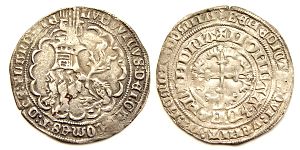Louis II, Count of Flanders facts for kids
Quick facts for kids
Louis II
|
|
|---|---|
 |
|
| Born | 25 October 1330 Male Castle, Flanders, France |
| Died | 30 January 1384 (aged 53) Lille, Flanders |
| Noble family | Dampierre |
| Spouse(s) | Margaret of Brabant |
| Issue Detail |
Margaret III, Countess of Flanders |
| Father | Louis I, Count of Flanders |
| Mother | Margaret I, Countess of Burgundy |
Louis II (born October 25, 1330, in Male – died January 30, 1384, in Lille), also known as Louis of Male, was an important ruler in the Middle Ages. He was a member of the House of Dampierre, a powerful family. Louis II was the Count of Flanders, Nevers, and Rethel starting in 1346. Later, from 1382 until his death, he also became the Count of Artois and Burgundy.
Contents
Family and Early Life
Louis II was the son of Count Louis I of Flanders and Countess Margaret I of Burgundy. His mother was the daughter of King Philip V of France. Louis was baptized by Bishop Pierre Roger, who later became Pope Clement VI.
His father arranged for Louis to marry Margaret. She was the daughter of Duke John III of Brabant. This marriage helped improve relations between Flanders and the Duchy of Brabant. Louis and Margaret had one daughter, Margaret III, Countess of Flanders (born 1348, died 1405).
Becoming a Ruler
Louis II became count in 1346 after his father was killed. This happened during the Battle of Crécy, where his father fought against the English King Edward III of England. Louis inherited the French counties of Flanders, Nevers, and Rethel.
At this time, there was a big conflict between England and France, known as the Hundred Years' War. The powerful trade groups (called guilds) in Flanders relied on wool from England. They wanted Louis to accept King Edward III as his ruler. They even tried to arrange for Louis to marry King Edward's daughter, Isabella.
However, Louis did not want this. He secretly left Flanders and went to the court of King Philip VI of France. In 1347, he married Margaret of Brabant, as planned by his father. This marriage made some people in Ghent angry, and they started a revolt.
The terrible disease known as the Black Death also spread through Flanders during this time. Despite these challenges, Louis made an agreement with the English king in 1349. This allowed him to return to Flanders and officially take his place as count.
Challenges and Victories
In 1350, Louis showed his independence by refusing to pay homage (a sign of respect and loyalty) to the new French King John II of France.
When his father-in-law, John III of Brabant, died in 1355 without any sons, Louis tried to claim the Duchy of Brabant. However, he could not take it from his sister-in-law, Joanna.
Louis did manage to defeat the Brabant army in the Battle of Scheut in 1356. He also captured important cities like Mechelen, Brussels, Antwerp, and Leuven. But he could not fully defeat Joanna, who had the support of her husband, Duke Wenceslaus I of Luxembourg, and his powerful brother, Emperor Charles IV.
In 1357, they signed the Peace of Ath. Through this agreement, Louis gained control over the small Lordship of Mechelen and the busy city of Antwerp.
A Clever Ruler
Louis tried to rule in a practical way, focusing on what was best for Flanders. He kept Flanders neutral during the ongoing Hundred Years' War between France and England. This made both countries happy with him and brought a time of peace and wealth to Flanders.
Inside Flanders, his main goal was to stop different groups from joining together against him, which had happened to his father. For most of his rule, he was successful at this.
In 1355, Louis II arranged for his seven-year-old daughter, Margaret, to marry the young Duke Philip I of Burgundy. Sadly, Philip died from the plague four years later.
Since Margaret was now the heir to her father's lands, many powerful people wanted her to marry their sons. Two important suitors were Edmund of Langley, son of King Edward III of England, and Philip the Bold, son of King John II of France. Philip the Bold also became the new duke of Burgundy in 1363.
After several years of difficult talks, Count Louis II agreed to Margaret marrying Philip the Bold. In return, Louis received control of some important areas in Flanders, including Lille, Douai, and Orchies. He also received a large payment of 200,000 livre tournois (an old type of French money). Margaret and Philip were married in Ghent on June 19, 1369.
Later Years and Challenges
Even though Louis was a skilled ruler, his expensive lifestyle put a strain on Flanders' money. This led to more problems and unrest. However, even in his later years, he managed to get the support of the citizens of Bruges against revolts in Ghent.
The last years of his rule were marked by civil unrest. In 1379, his son-in-law, Philip the Bold, helped him put down another revolt in Ghent. The people of Flanders rose up again in 1382 under Philip van Artevelde. They forced Count Louis out of Flanders after the Battle of Beverhoutsveld.
However, Philip the Bold used his influence to get a French army to help Louis. The Flemish rebels were soundly defeated at the Battle of Roosebeke. Despite this, the citizens of Ghent continued to fight, even with some help from England, until after Louis's death in 1384.
Two years before Louis died, his mother, Margaret, had passed away. This meant Louis also inherited the County of Artois and the Free County of Burgundy (also known as Franche-Comté).
See also
 In Spanish: Luis II de Flandes para niños
In Spanish: Luis II de Flandes para niños


